All 5 entries tagged Athens
View all 9 entries tagged Athens on Warwick Blogs | View entries tagged Athens at Technorati | There are no images tagged Athens on this blog
June 01, 2019
Countermarks on Athenian Tokens
Athens is the city in the Classical world that minted tokens on a scale previously unparalleled, only to be superseded by Rome. Tokens in Athens had a continuous life of about seven centuries and facilitated numerous aspects of public life: the functioning of the Council, the Courts, the Assembly, participation in the Dionysia, the Panathenaea and the other festivals.
Researchers have commented on the relations between tokens and coins and have asked to what extent coins functioned as an archetype for tokens. The answer is clearly negative. Classical tokens do not resemble coins and functioned in an altogether different manner. They were probably used for the selection procedure of citizens who would fill offices and serve as public functionaries, and consecutively for the allotment of citizens to offices and even ‘workplaces’.
 |
|
1.) Agora Museum IL1463.
Alpha with countermark of winged
caduceus, 31 mm.
|
Tokens with letters signify the allotment, the fact that citizens would be allotted randomly to offices (fig. 1). And here is a seeming similitude to coins: there exist letter tokens which are countermarked. But contrary to coins, where countermarking meant the revalidation of the item, so that issues were put afresh into circulation, the countermarking in this case signifies the particular sector of public life and complements the token design. Flans are particularly wide, probably because the placement of the countermark was conceived from the beginning. The designs of the countermarks – the winged caduceus (fig. 1), the kernos and the amphora in an ivy-wreath – are well attested in categories of official artefacts and they qualify as designs of the state seal (sphragis demosia). The exact offices they represent can only be conjectured but they can be seen as analogous to the stamps on the juror’s allotment plates; here the ‘owl in wreath’ stamp meant that the citizen was eligible for jury allotments and the ‘Gorgoneion’ stamp meant magisterial allotments.
It seems that the solution of the countermark was short-lived because only three out of the approximately three hundred Hellenistic tokens excavated in the Athenian Agora have a countermark placed next to a letter type.
Contrary to the rarity of countermarks on tokens dated to before Sulla’s sack of the city (86 BC), which practically marks the end of the city’s independence, countermarks are far more common in Athens of the Roman Imperial Period (fig. 2). In particular more than 200 specimens demonstrate at least one countermark out of the 620 tokens that can be securely dated to the period between the first century AD and AD 268, when the destruction inflicted on the city by the Herules marked the end of token use in Athens. It is worth noting that most of the tokens in strata and deposits containing Herulian debris carry countermarks. Our attention is particularly attracted by the countermarks of ‘snail and rabbit’ and ‘stork holding lizard by the tail’, which are the most abundantly attested. In the trench containing dumped fill as a result of clean-up operations after the Herulian sack, countermarked tokens co-exist with un-countermarked specimens, albeit they are found on the same types. These mainly celebrate the cults of Asklepios, Hygieia and Telesphoros (fig. 3) or Asklepios alone, Dionysos (fig. 4), Serapis, Zeus and Nike, Athena and Nike and also Themistocles, and the Minotaur, alone or with Theseus. The latter cases may be related to the claims of Athenian elite families for status and prestigious ancestry.
 |
|
2.) Selection of tokens excavated in and around the Attalos Stoa,
Athenian Agora (Archives of the American School of Classical
Studies 2012.25.0091).
|
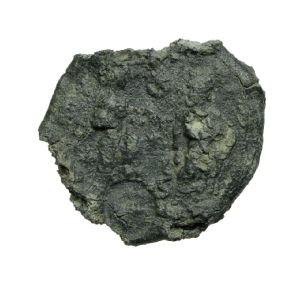 |
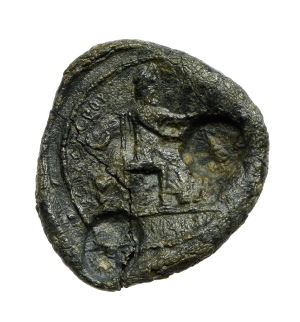 |
The same pattern is also encountered on the tokens found in piles on the floors of the Attalos Stoa and also in the immediate vicinity of the Attalos Stoa to the south.
 |
Specimens are also quite often found to have been countermarked twice by the same stamp, such as the token with an Athena bust and two countermarks of the snail and rabbit type (fig. 5). More puzzling are the Herakles and tripod tokens, which on their reverse side bear three distinct countermarks: stork and lizard, snail and rabbit, and a third design not easily identifiable (fig. 6).
Both the designs of stork and lizard and of snail and rabbit relate to universal symbols and refer to narratives that could be easily adapted as badges and emblems. The stork in particular was very popular in medieval heraldry.
The meaning of the countermarks is not easy to decode. The countermarked tokens capture only a moment in the history of Athens, because they represent the types and specimens that were in circulation at the time of the Herulian Invasion and their preservation may be thought random. Even the hoarding of countermarked pieces together with un-countermarked specimens may have been occasioned by the circumstances that prevailed shortly after the destruction. The interpretation of the countermarks is all the more hindered by the scarcity of tokens in the centuries from the Augustan Period to the mid-third century AD, which could serve as a point of comparison.
Margaret Crosby suggested that the same countermark on varying types might help to identify the same authority behind the issuing of the tokens. The purpose of these tokens would have been admissions to games and festivals, such as those referred to in inscriptions of the third century AD. In fact the legend on two of the types reads ‘of the Gerusia’, the council formed by notable Athenians and instituted by the emperor Commodus in the year AD 178/9, which had the agonothesia of festivals. The Attalos Stoa was thought to provide an advantageous view of spectacles and processions going along the Panathenaic Way and in view of this function, tokens excavated there seem to come as no surprise.
It is well known that the holding of offices in the Hellenistic and increasingly in the Imperial period involved considerable private expense. The iconography of the countermarks and even some of the token types might then be related to wealthy gerusiastai and office-holders in general, who competed for the recognition of the people, an idea already advocated by Margaret Crosby.
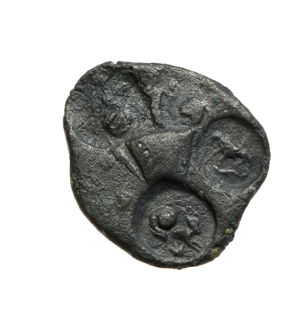 |
Along these lines, the countermarking a second or even a third time of tickets is to be considered as a renewal of their otherwise short lifetime. Roman period tokens were literary ‘time stamped’ and given out for a second or a third use since all the festivals were naturally recurring events. The registration of singular events constitutes the very essence of tokens across time, not unlike the modern-day block chain and its digital database or ledger.
This month's entry was written by Mairi Gkikaki. This blog forms part of the Project 'Tokens and their Cultural Biography in Athens from the Classical Age to the End of Antiquity', a Marie Skłodowska-Curie Action, which has received funding from the European Research Council (ERC) under the European Union's Horizon 2020 research and innovation programme under grant agreement No 794080-2.
Bibliography:
W. Bubelis, ‘Tokens and imitation in ancient Athens’, Marburger Beiträge zur Antiken Handels-, Wirtschafts-, und Sozialgeschichte 28 (2010), 171-195.
E. Curtius, Über Wappenstil und Wappengebrauch im klassischen Altertum (Berlin, 1874).
M. Crosby, ‘Lead and Clay Tokens’, in M. Lang and M. Crosby, Weights, Measures and Tokens. The Athenian Agora, vol. 10 (Princeton, 1964), 69-146.
D.J. Gaegan, The Athenian Constitution after Sulla, Hesperia Supplements 12 (Princeton, 1967).
M. Gkikaki, 'Tokens in the Athenian Agora in the Third Century AD: Adverstising Prestige and Civic Identity in Roman Athens', in A. Crisà, M. Gkikaki, and C. Rowan, Tokens: Cultures, Connections, Communities (London: Royal Numismatic Society, forthcoming)
S. Killen, Parasema. Offizielle Symbole griechischer Poleis und Bundesstaaten (Wiesbaden, 2017).
J.H. Kroll, Athenian Bronze Allotment Plates (Cambridge, 1972).
J.H. Kroll, ‘The Athenian imperials: results of recent study’, in J. Nollé, B. Overbeck and P. Weiss (eds), Internationales Kolloquium zur Kaiserzeitlichen Münzprägung Kleinasiens. 27-30 April 1994 in der Staatlichen Münzsammlung (München, 1997). 61-9.
M. Lang, ‘Allotment by tokens’, Historia: Zeitschrift für Alte Geschichte 8, 1959, 80-9.
B. Maurer, ‘The Politics of Token Economics’, in. A. Crisà, M. Gkikaki, and C. Rowan, Tokens: Cultures, Connections, Communities (London: Royal Numismatic Society, forthcoming).
K.D. Mylonas, ‘Αττικά Μολύβδινα Σύμβολα’, ArchEph 40, 1901, 119-22.
J.H. Oliver, The Sacred Gerusia. The American Excavations in the Athenian Agora. Hesperia Suppl. 6 (Princeton, 1941).
P.J. Rhodes, A Commentary on the Aristotelian Athenaion Politeia (Oxford, 1981).
G.C. Rothery, Concise Encyclopedia of Heraldry (London ,1994, reprint of the book first published in 1914).
H.A. Thompson and R.E. Wycherley, The Agora of Athens: The History, Shape and Uses of an Ancient City Centre, The Agora of Athens, volume 14 (Princeton, 1972).
P. Tselekas, ‘Countermarks on the Hellenistic Coinages of Lesbos’, in P. Tselekas (ed), Coins in the Aegean Islands. Proceedings of the Fifth Scientific Meeting 16-19 September 2010, (Athens, 2010), 127-153
O. Van Nijf and R. Alston (eds), Political Culture in the Greek City after the Classical Age (Leuven, 2011)
May 01, 2018
Tokens for the Eleusinian Mysteries
The intersection of imagery between tokens and coins in Hellenistic Athens remains an understudied phenomenon. It has previously been thought that tokens functioned as substitute for coinage or as an alternative currency according to a ‘functional’ approach. A more semiotic approach to these objects has underlined the obvious verisimilitude of Hellenistic tokens to the moneyer’s symbols of Athenian New Style coinage, identifying the common imagery used by a wide set of media, which included tokens, coins, weights and measures, as well as bronze allotment plates (pinakia).

Athenian lead token from Göttingen with a poppy head between two ears of wheat. (Göttingen, As-Pb-085, 13mm)
A token, shown above, struck only on one side with a poppy head between two ears of wheat and recently studied in the University Museum of Göttingen, returns to this question. The type follows closely coin types of the 70s BC. (J.H. Kroll with contributions by A.S. Walker, The Greek Coins, The Athenian Agora, vol. 26, Princeton: American School of Classical Studies at Athens, 1993, 118; 133-134). It is very probable that two different but closely associated workshops prepared two distinct sets of dies. The fact that dies for tokens have to date never been found, in conjunction with the evidence that indicates a continuous circle of disposing of the old tokens and recycling them, points to the fact the polis carefully controlled the production of tokens.
Tokens gave access to a broad array of state pay: for example assembly pay, misthos ekklesiastikos, from the late 5th cent. BC, juror’s pay from the late 5th century BC onwards, theatre tickets paid out on an ad hoc basis from the late 5th century BC, and regularly from the theorikon fund from the middle of the 4th century BC. Fraudulent behaviour then is likely to have been quite common. In fact it is impossible to know how many, if any, of the tokens surviving today are ancient counterfeits.
Among the tokens with ‘coin imagery’ a particular group stands apart. These are the tokens that fully copy or closely follow the imagery of Eleusinian coinage, struck in the name of Eleusis and likely connected to festivals. The ‘poppy-ear wheat token’ is one of them. But the ‘kernos’ or ‘plemochoe’, a type of vessel, is a far more popular ‘Eleusinian’ device on tokens.
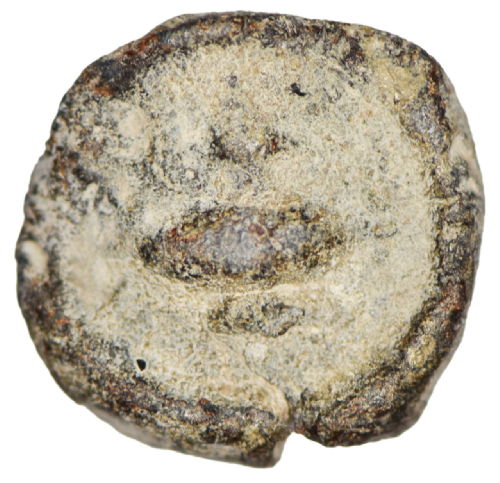 |
 |
|
Token showing a kernos.
Göttingen, AS-Pb-090, 12mm
|
Token showing a kernos.
Göttingen, As-Pb-091, 11mm
|
Two such tokens showing a kernos are also found in the University Coin Collection of Göttingen, shown above. Remarkable also is a bronze token with a kernos on the reverse, accompanied by the legend ΔΗΜΟΣ ΑΘΗΝΑΙΩΝ, ‘the demos of Athens’ (Svoronos 1898, 124). The vessel is also attested as a countermark on a lead token of the letter series (Crosby 1964, L5). The kernos appears for the first time on Athenian bronze coinage (hemiobols and chalkoi) of the period following the evacuation of the Macedonian garrisons from the forts of Attica in 229BC.
The last day of the Eleusinian Mysteries was called ‘Plemochoai’, named after these particular vases, which were used ceremonially. A. Dumont has suggested that tokens carrying these designs could have been used in the Eleusinian Festival. The circumstances could have been similar to the ones that prompted the ‘ΕΛΕΥΣΙ coinage’, the coins carrying a reference to Eleusis. Perhaps tokens were employed as credit when the appropriate money was not available. Or – more probably – tokens were issued by the Boule and the magistrates responsible for the Eleusinian Mysteries or the panegyriarch, who presided over the panegyris (assembly) related to the festival. Today ‘kernos-tokens’ have been found in and around the tholos of the Agora in Athens.
The connection of tokens to Athenian Festivals in the Hellenistic Period is also attested through another important find: all the ‘Panathenaic Amphora – tokens’ have been found very near the so-called Arsenal, on the North side of the Agora, the only building which contained sherds of Panathenaic Amphoras.
This month's entry was written by Mairi Gkikaki as part of the Token Communities in the Ancient Mediterranean Project.
Bibliography
W. Bubelis, ‘Tokens and Imitation in Ancient Athens’, Marburger Beiträge zur Antiken Handels-, Sozial- und Wirtschaftsgeschichte 28, 2011, pp. 171-195.
Fr. De Callataÿ, ‘Les Plombes à type Monétaires en Grѐce Ancienne: Monnaies (officielles, votives ou contrefaites), jetons, sceax, poids, épreuves ou fantaisies?’ RN 167, 2010 pp. 219-255.
M. Crosby, ‘Lead and Clay Tokens. Part II’, in Lang, M. Crosby, M., Weights, Measures and Tokens. The Athenian Agora, vol. 10 (Princeton: American School of Classical Studies at Athens, 1964).
L. Deubner, Attische Feste (Berlin 1932).
A. Dumont, De Plumbeis apud Graecos Tesseris (Paris 1870).
M. Gkikaki, 'The Collection of Athenian Lead Tokens at the University Museum of Göttingen' (SchwNumRu forthcoming)
J.H. Kroll with contributions by A.S. Walker, The Greek Coins, The Athenian Agora, vol. 26 (Princeton: American School of Classical Studies at Athens, 1993).
C. Mann, Spent or Saved? The Circulation of Festival Coins Struck for the Eleusinian Mysteries, Unpublished MA Essay (University of Warwick 2017, RNS Parkes Weber Prize)
G.E. Mylonas, Eleusis and the Eleusinian Mysteries (Princeton 1961).
M.P. Nilsson, Die Geschichte der Griechischen Religion (München 1941).
P.J. Rhodes, The Athenian Boule (Oxford 1972).
I.N. Svoronos, ‘Περί των Εισιτηρίων των Αρχαίων. Μέρος Α΄ Εισιτήρια του Λυκούργειου Διονυσιακού Θεάτρου και της Κλεισθενείου Εκκλησίας των Αθηναίων’. JIAN 1, 1898, pp. 37-84.
March 01, 2018
The Athenian polis and its 'winged' symbola
In the three centuries between the recovery of Athens after the Peloponnesian War in the 390s and Sullan Sack in 86 BC the polis (city) was regularly minting symbola – the Greek word for tokens – for a variety of purposes. The images these tokens carry shed light on the fabric of Athenian civic life. These devices, dissimilar to the usual repertoire of the small-scale works of art, are peculiar to the polis ideology. Since they are lacking clarifying inscriptions and because they were discontinued in the Imperial Period, their meaning today is even more cryptic.
The roles the Athenian symbola played were very much linked to aspects of polis institutions, and the messages of these tokens were shared by members of a ‘single community of interpretation’. Inspiration was derived from the world of nature and three creatures deserve our attention here: the cicada, the wasp and the locust.
 |
| Athenian token showing a cicada. |
The cicada (Postolacca 1868, 415, which is pictured left) refers to the much celebrated ‘autochthony’: the Athenians were proud that they had always inhabited the same land, and were ‘born out of the land’ (gēgeneis), just like the cicada (Plato, Symposium, 191C). The myth behind the notion was derived from observations of the cicada’s life cycle: the nymphē remained underground until the fully-grown cicadas emerged from the earth. Cicadas were proudly worn by the famed generation of Marathon-fighters (Thucydides 1.6.3) and the cicada was considered a particular sign of patriotism, going as far as to function as a conscious tribute to past generations. Expressions of political conservatism cannot be not excluded if Aristophanes’ brief mentions of the insect are taken into consideration (Equites 1331; Nubes 984).
Beyond this the cicada is inseparable from music. Its song inspired the Greek spirit, who acknowledged that the cicadas had a divine substance. This charming singer was called the ‘nightingale of the muses’, ‘the soothsayer of the Muses’, and a ‘musician like Apollo’. Plato in Phaedrus narrates that cicadas were originally men, who were carried away by the music of the chorus and the flute: ‘they were so struck by the pleasure of it that they sang and sang, forgot to eat and drink and died before they knew it’ and were reborn as cicadas (259b-c). This passion for music makes the cicada the archetype of the polis; a particular lifestyle defined by openness to the word and deriving from trust to the native spirit of its citizens along with liberality and self-determination in private affairs, as it is exhorted in Pericles’ Epitaph (Thucydides 2.39). It cannot escape us that this very passion stands at the roots of the dual principle of ‘gymnastikē for the body, mousikē for the soul’ (Plato, Res Publica, 376C) with mousikē meaning not just education, but a particular form of socialization, indispensable for the formation and functioning of the polis. The cicada, then, becomes Athena’s companion (Anthologia Palatina 6.120.7-8).
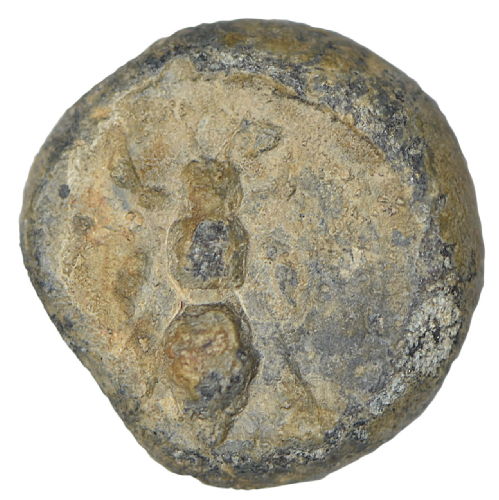 |
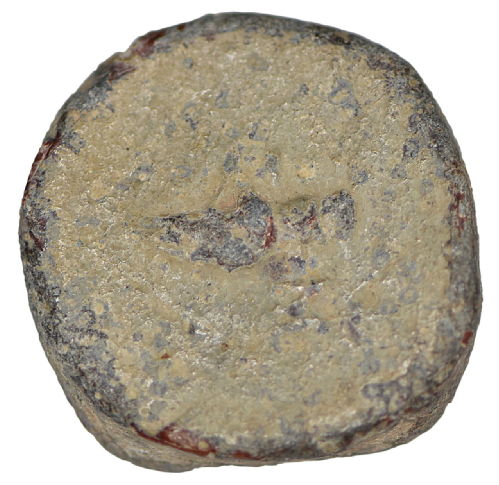 |
| Athenian token showing a wasp. | Athenian token showing a locust. |
If the cicada embodies inherent values of Athenian citizenship, the wasp, also encountered on symbola (University Museum Göttingen AS-Pb-010, 10mm, previously unpublished and shown above), demands an even more challenging approach, especially when considering the apparently harmful nature of the creature. Again here consultation of written sources is indispensable. The wasp stands for anger in Athenian politics, anger resulting from fundamental conflicts in the public forums of debate, which included the Assembly, the Council, and the People’s Courts. Especially through the latter the rebellious anger of the citizen is carefully channelled and finds entrance into the public sphere. As a result the extravagances of elite struggles are tempered and democratic citizenship and the resulting qualification to rule is processed. The litigious wasps ‘have stingers extremely sharp, sticking out from their rumps, that they stab with, and they leap and attack, crackling like sparks’ (Aristophanes, Wasps, 223-27).
A radically different message is conveyed by the locust’s presence on Athenian symbola (shown above, University Museum Göttingen AS-Pb-107, 18 mm, previously unpublished). Given the polis’ constant preoccupation for the safety of the harvest at home on one hand and for ensuring adequate sources of grain from abroad on the other, the locust shouldn’t surprise us. In Hellenistic Athens the loss of the harvest and famine wouldn’t have been the outcome of locust swarms alone, but an event that could also result from long periods of warfare and the ensuing pillaging of the countryside. So it was in the mid-290s BC that the Hellenistic general Demetrius Poliorketes’ 150,000 bushels of grain provided much desired relief after lengthy siege (Plutarch, Demetrius, 34.4). The destructive agent on these symbola, which probably could have been exchanged for wheat, would have signified that the threat had passed and could even have had an apotropaic function.
Sincere thanks are due to Dr. Daniel Graepler, curator of the University Museum Göttingen.
The images were digitally remastered by Matthias Demel.
 |
This month's coin of the month was written by Mairi Gkikaki as part of the Token Communities in the Ancient Mediterranean Project.
Bibliography:
Bodson, L. (1978). HIERA ZOIA. Contribution a la place de l’animal dans la religion grecque ancienne. Academie Royale de Belgique. Mémoires de la Classe des Lettres LXIII,2: 9-43.
Habicht, Chr. (1997). Athens from Alexander to Antony. Harvard University Press.
Hoffmann, H. (1997). Sotades. Symbols of Immortality on Greek Vases. Oxford: Clarendon Press.
Mabel, L. and Crosby, M. (1964). Weights, Measures and Tokens. The Athenian Agora results of the excavations conducted by the American School of Classical Studies, Volume X: 72-146, pls. 19-32.
Ober, J. (1989). Mass and Elite in Democratic Athens. Rhetoric, Ideology and the power of the people. Princeton University Press: 141-148.
Ober, J. (1998), Political Dissent in Democratic Athens. Intellectual Critics of Popular Rule. Princeton University Press: 46-47.
Oliver, J.G. (2007). War, Food and Politics in Early Hellenistic Athens. Oxford University Press.
Postolacca, A. (1868). Piombi Inediti del Nazionale Museo Numismatico di Atene, Annali dell’ Instituto XL: 268-316 with pl. K; pl. Monumenti Inediti VIII, pl. LII.
Zumbrunnen, J. (2012). Aristophanic Comedy and the Challenge of Democratic Citizenship. Suffolk: Boydell and Brewer: 60-80.
November 01, 2013
The YHD Coins of Judah
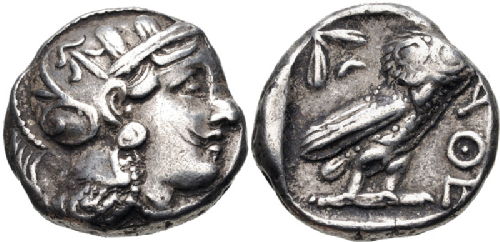 |
| Athenian Tetradrachm, 400-353 BC |
During the latter half of the fifth century BC, proud Athenians might have professed their coinage to be the world’s reserve currency; the ubiquitous ‘owls’ were recognised even in Persian-held territories. In the dying days of the Peloponnesian War, however, Athens found herself in both military and financial straits: to meet the costs of warfare, the citizens were reduced to plundering gold plate from the statues of Nike on the Acropolis, and the volume of newly-minted ‘owls’ entering circulation was drastically reduced. For undocumented reasons, a short time after, private and public individuals in the Persian satrapy of Judah began producing imitation coinage, featuring Athenian iconography.
Spot the Difference
Our two coins were both minted in the fourth century bc. The silver Athenian tetradrachm is an easily identifiable type: the well-defined helmeted head of Athena on the obverse; the owl, olive spray and the lettering ΑΘΕ [ΝAION] “of the Athenians” on the reverse. At first glance, the design on its counterpart, a Jewish obol, looks like a poor man’s copy. Athena’s features are somewhat oriental, and the owl has lost some fine detail. Perhaps Near Eastern die-engravers were unable to reproduce the Athenian images, or maybe, more likely, the need for a pixel-perfect replica simply didn’t exist. If official ‘owls’ were only required in the Near East and Transjordan for long-distance trading, any political significance of the images would have been lost – it was the worth of the metal that mattered.
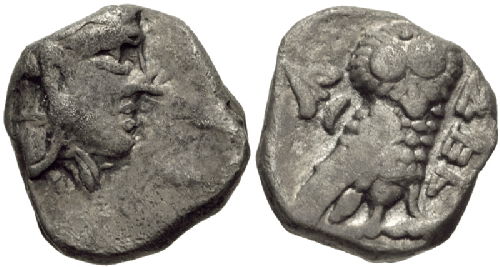 |
| Persian YHD coin of Judah, 375-332 BC |
The clearest difference between the two coins is the reverse legend, which on the Jewish coin, is written in paleo-Hebrew and reads YHD (sometimes YHWD). This name is used in the Bible when referring to the satrapy of Judah during the Persian period; also, it is found impressed upon the handles of contemporary jars excavated in Jerusalem. Hence, the legend is openly advertising the provenance of the coin: no one is trying to ‘pass off’ this owl as an Athenian original. Similarly, the replacement of the olive spray with a lily on the reverse signifies its foreign mint: the biblical temple built by King Solomon had pillars decorated with ‘lily-work’, the lily being a traditional symbol of Jerusalem.
Small Change
Over time, especially after the conquests of Alexander the Great, the yhd coin types altered. Without apparent repercussions, the Athenian owl was replaced by a falcon; the profile of Athena by a male head. Yhd coins were never, it seems, consistent with Athenian weight standards and denominations. So we are left with the question: when they began minting, why did the Persian satraps in Judah borrow from the Athenians at all?
The answer is probably to be found in the persistent conservative trend which pervades numismatic history: in order for people to accept that something IS money, it has to LOOK like money. Athenian owls were so widespread during the latter half of the fifth century that local changes to coinage design were necessarily small, in order to preserve wider confidence in the metal’s worth. We might update the idea by imagining the suspicious glance which greets a Scottish five-pound note in Cornwall today: perhaps it is akin to the reception of a newly-minted silver coin in Jerusalem 2400 years ago, although in the ancient case, a lily rather than a thistle gives the game away.
 This month's coin was chosen by Joe Grimwade, a second year undergraduate at the University of Warwick. He chose his 'Coin of the Month' after attending the British Museum's Numismatics Summer School, and is about to begin working with Warwickshire's Museum Service on their Roman coinage.
This month's coin was chosen by Joe Grimwade, a second year undergraduate at the University of Warwick. He chose his 'Coin of the Month' after attending the British Museum's Numismatics Summer School, and is about to begin working with Warwickshire's Museum Service on their Roman coinage.
Images above reproduced courtesy of Classical Numismatic Group Inc., (Electronic Auction 294, lot 306 and Electronic Auction 220, lot 194) (www.cngcoins.com)
September 13, 2013
Athens and the Augustan Cultural Revolution
 |
|
Coin of Athens with head of Gorgoneion |
As Spawforth has demonstrated in his Greece and the Augustan Cultural Revolution, the transition of Rome from a Republic to a principate under Augustus meant that Greeks (and others) were forced to redefine themselves in view of this new power structure. In Greece, this period saw an emphasis on the glorious archaic past, epitomised in the glory and achievements of archaic Athens, and, to a lesser extent, Sparta. New 'old' temples were built, and new 'old' festivals revived. This was in part a reaction to how the Romans (and Augustus) saw Greece, a vision that emphasised the legacy and achivements of the Classical period.
This 'return to the glory days' can also be traced on coinage at the time. Towards the end of the Republic (42-39 BC), a bronze issue at Athens was struck showing the head of a gorgoneion on the obverse and Athena on the reverse. Kroll pointed out that the inspiration for this rather obscure obverse type must have been the original coins of Athens struck in the 6th century BC - today these coins are called Wappenmünzen, alluding to the scholarly idea that the types were familial shields, a theory that is now discounted. (Kroll, J. 1972. Two hoards of first-century B.C. Athenian bronze coins. ΑΡΧΑΙΟΛΟΓΙΚΟΝ ΔΕΛΤΙΟΝ, 27, 86-120.)
 |
| Wappenmünze of the 6th century BC |
It is remarkable that the type of the gorgoneion should be revived after a period of around 500 years - the inspiration may have been a text referring to the type; it is hard to believe that any of the original Wappenmünzen were available to be viewed at this time. The revival of old types and/or reference to the archaic history of Greece is also found on other coin types struck by cities in the region after they come under Roman dominion - Lycurgus, for example, appears on the coins of Sparta, and the Roman provincial issues of Cyrene reference earlier silver issues that carried images of the silphium plant.
The Athenian example is of great interest since it demonstrates not only a reaction to Roman 'visions' of Greece, but an interest in old coin types and their resuscitation. This brings to mind Suetonius' account of Augustus (75), which notes that Augustus had an interest in old and foreign coins. The Roman vision of the Greeks, and the particular Roman understanding of coinage as a memorial as well as a piece of money, meant that the gorgoneion once again graced Athenian coinage, if only for a brief period. Greece looked to their past in order to place themselves in a new future.
Images above reproduced courtesy of Classical Numismatic Group (www.cngcoins.com).
 Clare Rowan
Clare Rowan

 Please wait - comments are loading
Please wait - comments are loading

 Loading…
Loading…

